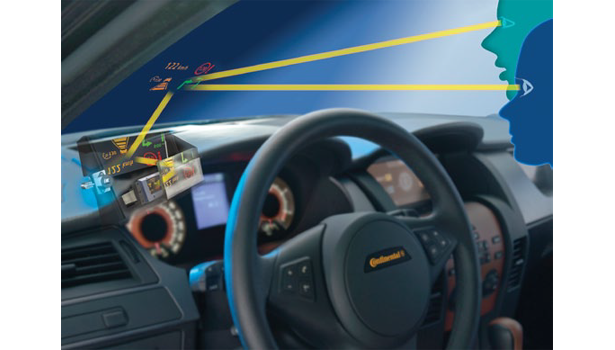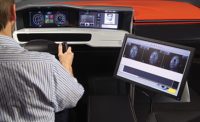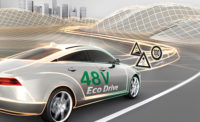The auto industry has a long history of borrowing ideas from the aerospace sector, ranging from aerodynamic styling to lightweight materials. The latest adoption is head-up display (HUD) technology, which was originally developed for fighter jets.
Instead of traditional instrument clusters mounted on a dashboard, HUDs project speed, warning signals and other vital data on a car’s windshield. The information appears to float several feet in front of a driver’s eyes.
Projecting information directly into the driver’s line of sight allows people to process it up to 50 percent faster—due to shorter eye movement—and keep their attention focused on the road ahead.
Head-up display technology is currently available on high-end vehicles, such as the Audi A6, BMW 7 Series, Cadillac CTS and Lexus RX 35. But, it’s starting to show up in other segments. In fact, more than 35 vehicle models currently available in the United States have standard or optional HUDs, ranging from the Mazda3 to the Mini Cooper.
According to IHS Automotive, 9 percent of all new automobiles in 2020 will be equipped with HUD technology vs. 2 percent in 2012. Sales this year alone are projected to climb 7 percent to 1.3 million units.
Vehicles equipped with HUD technology often have a small square depression on the top of their dashboard behind the steering wheel. This contains a projector and a system of mirrors that beams a high-contrast image onto the windshield.
Key components of HUD systems include mirrors, heatsinks, optical films (for light refraction), graphics processors, digital light processing projectors, LCDs, LEDs and OLEDs.
“In general, [all those items] are ready for [widescale] automotive applications,” says Mark Boyadjis, senior analyst and manager of infotainment and HMI at IHS Automotive. “OLEDs are about the only component that is still unproven to stand up to automotive temperature ranges.”
As the technology matures, HUDs are growing in size. Earlier this year, at the North American International Auto Show in Detroit, Panasonic Automotive Systems Co. of America displayed a system that projects an image 16 inches wide by 6 inches high. That’s about twice the size of most current head-up images.
“Right now, most HUDs max out [with a field of view of] five inches or less on a diagonal,” Boyadjis points out. “Prototypes from various suppliers [envision] whole-windshield HUDs as a possibility. But, with growing size comes growing concern for distraction.
“Making a screen bigger doesn’t automatically make it better,” warns Boyadjis. “This is true in normal vehicle displays, as well as HUDs. Focus on intuitive design and key redundant information cues are what will make HUDs better and better, even as they get bigger and bigger.”
In the future, HUDs may alter the interior design of vehicles by eliminating the need for a center console equipped with a screen and a digital instrument cluster. A handful of Tier 1 suppliers, such as Bosch, Continental, Delphi, Denso, Johnson Controls, Nippon Seiki and Visteon, are currently exploring this issue. Engineers are scrambling to develop new HUD technology that can be cost-effectively mass-produced, while addressing issues such as noise, vibration and harshness.
“Manufacturing head-up displays in large numbers is a challenge, because of the optomechanics’ strict precision standards,” says Ralf Worzischek, senior project manager at Continental AG, which supplies state-of-the-art HUD systems to Audi, BMW and other automakers. At its assembly plant in Babenhausen, Germany, the company produces a next-generation system that’s based on digital micromirror device technology.
The linchpin of the HUD’s success is optical quality, which in turn directly depends on the quality of the mirrors. As a result, Continenal assembles its products in clean rooms. Other key components assembled in-house include springs, a stepper motor and an LED light reflector board. Purchased parts include the display, the inner visor and a metal housing.
“The bolting-up of the individual components is done by a pneumatic torque-controlled screwdriver, which produces a vibration-resistant joint between the injection-molded plastic parts, made from glass-filled polyphenylene sulfide, and the metal bolt,” says Worzischek.
The stepper motor features a shaft that can tilt aspherical mirrors. “This makes it possible to adapt the visible level of the display later on, according to the body height of the driver,” Worzischek points out.
Engineers at Panasonic recently developed a HUD system that is 40 percent smaller than those currently offered by other suppliers. “This dramatic size reduction is achieved by utilizing specialized optics manufacturing technology derived from [our] projector and camera products, as well as specialized electronics cooling technology that draws on its consumer products legacy,” says James Grace, director of advanced engineering.
“Our proven consumer technologies allow us to build HUDs that are not only smaller, but much lighter than those currently on the market,” claims Grace. “The cooling technology we use provides five times the cooling capacity of competitive methods in the same amount of space.”.



